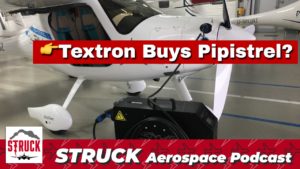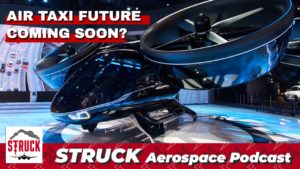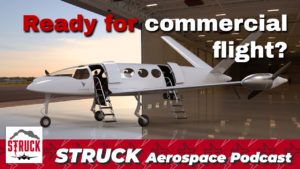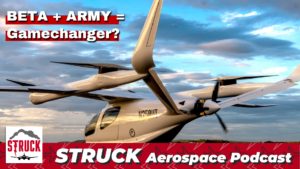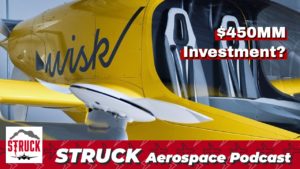Boeing is discussing selling off their Seattle HQ as the company ponders what the workplace looks like in the future. We discuss more lessons learned from the flight of the Barn Owl and the Airbus Albatross project, a new demonstrator with flapping wings. FedEx is testing drones in Memphis to help workers become more efficient, and Ampaire makes a long flight in their all-electric aircraft. Check out the video of FedEx’s drones here and the Airbus Albatross here.
Learn more about Weather Guard StrikeTape segmented lightning diverter strips. Follow the show on YouTube, Twitter, Linkedin and visit us on the web. Have a question we can answer on the show? Email us!
Podcast: Play in new window | Download
Transcript EP32 – Will Boeing Sell Their Seattle HQ? Airbus Albatross Project; FedEx Tests Drones at the Airport & Ampaire Makes Important Flight
Welcome back to the Struck podcast, episode 32. And in today’s episode, in our new segment, we’re going to chat about this potential Jetpack person flying at 6,000 feet above a LA, which is seemingly unconfirmed and also terrifying. Uh, and also we’re going to talk a little bit about Boeing, uh, potentially selling one of their HQs and considering some mobile.
Options. So as you know, as everyone is rethinking what office life looks like in our engineering segment, we are going to talk a lot about birds. There’s an interesting study on bird flight with the barn owl, also the air, uh, the Airbus albatross, which has actually, uh, segmented wings, if that’s the right term for it, but they sort of flap.
So really interesting demonstrators technology there. And then lastly, in our electric tech segment, we’re going to chat about drones being used at the airport, which is a pretty cool idea. And then the Ampaire. So their EEL, uh, aircraft has made some pretty impressive, uh, long haul flights. Well, maybe not a long haul, but some pretty impressive distance flights recently, uh, as in what they call the most, maybe commercially relevant, uh, electric aircraft at the moment.
So. Allen, let’s start with what is the deal with this? A jet pack. Yeah, I don’t know. Isn’t it crazy that we’ve had now two sightings from airplanes from multiple aircraft coming into lax, where they see what looks or appears to be a guy on it and a Jetpack cause the, the, the, the feedback to the control towers and the ground crews are.
It looks like a guy in a jet pack. So in a pilot’s eyes, you know, think about pilots is they usually have pretty good eyes. That’s one of the criteria to fly an airplane. So, uh, I would say that they’re probably telling you the truth that they actually seen this guy on a jet pack. Now, uh, the, uh, in this, uh, mobile phone dominated world where we’re taking video of.
All kinds of things. It’s weird that nobody has posted any video, or I haven’t seen any video on TikTok, Facebook, Twitter, Snapchat. And you know, there’s just no video of this thing occurring. And it seems like if it’s, if it’s some sort of prank, there’ll be a ton of video online about it that, uh, would get picked up somewhere.
But we don’t have that either. So there’s a lot of curiosity about it because. If it ever got to a situation where it ran into an airplane, uh, that result would not be good. And if it is a real person, now there’s been conjecture that it’s a dummy attached to a jet pack or some sort of, um, I’ve even heard some discussion about being a helium filled thing that just floats around.
Maybe it is maybe it isn’t who knows, but it just don’t. Want to be playing around airports. That’s one of the sort of basic fundamental rules around airports is don’t put things in the air where an airplane can run into them because you’re risking a lot of people’s lives for some nonsense that you want to go pull off.
Uh, but do you think it’s a real jet pack? Dan D well, you’re reading this article from NBC news. Uh, so David May, may man is the CEO of Jetpack Aviation in LA. And he said, it’s kind of funny that they have five jet packs. They’re all under lock and key only he and his chief engineer have those keys. So they’re like, no, one’s taking these out, you know, under our nose.
And, uh, and he also said, I mean, he had a lot of really good reasons that this is probably not a one of his packs for sure, but a B S you know, some, so he said basically their model holds 12 gallons of fuel. Which is about 10 minutes worth of flight time. And it would take about seven minutes to climb to 6,000 feet, which is where the recent sighting was.
Right. So he said to get up there and come back down, he said, it’s pretty unlikely. Like you probably just wouldn’t make it fuel wise. And then when it does come down, it uses like a, a large pan or shoot, essentially. So he said these things are so loud. They’re super interesting. Obviously they calm down with a parachute.
He was like, why wouldn’t you, you know, this was actually happening. Someone would have taken a cell phone video, see this, see going on. Like, there would be evidence that someone’s doing this, but nothing’s surfaced so far. So he thinks it’s just a drone. Like some kid just like made some crazy drone and I don’t know, maybe attached to the dummy to it.
You don’t know who knows, but what it does seem, it does seem pretty implausible the way he describes it. Well, okay. So let’s get back to the, to the real interesting part of this, which is the David Blaine balloon stunt. Did you see that David Blaine? Magician? I watched some of the, I think he’s an interesting dude.
I watched some of it, but it was like a three hour long, like YouTube video, a watch. I watched a little bit of it. Yeah. Well I think I skipped, but I think I skimmed enough where I didn’t like get the point. So the little that I watched, I like screwed it up for myself. I should have skimmed more effectively.
Well, do you think that this may be a follow on a copycat to what Blaine was doing? Because he basically took a whole bunch of, of helium balloons and titled onto a lawn chair. Isn’t that what happened? Or he was holding onto them. He was physically holding onto them for a long time. Wow. Holding onto it.
But it clear like that. Wasn’t what was keeping him attached to it. Right. And he was just holding it, holding on there for a stability for life. Cause I was looking at that. I’m like, there’s no way you’re only suspended by your forearms right now. That just wouldn’t be realistic, but no, but yeah, so, I mean, I wouldn’t, you know, you never know something could surface, this is actually like Batman or Ironman or something, you know, David Blaine, who’s probably the closest to being probably Batman, you know?
I think one of the things, yeah, that’s true. But one of the Blaine. Uh, problems or what they were trying to prove, I guess, is that he went up like 23,000 feet, 24,000 feet. Something like that. Isn’t the air gets really thin. It gets really difficult to breathe it at 6,000 feet. It’s not really all that difficult to breathe.
So Blaine was going to another level, but I just wonder if this is a copycat of what he was doing. It’s starting to starting to feel like that. So Boeing is considering selling their commercial headquarters. Um, Alan, you, have you been to their, uh, Seattle headquarters? Yes, I have. A couple of different times.
Uh, it’s a really interesting building. It’s a very modern building. And one of the, as you throw out your drive through the Boeing complex, it’s one of the buildings that stands out to you. So it, it, um, how has the Boeing hierarchy for a long time, until they all moved to Chicago to make their new headquarters and.
Uh, I still don’t really understand the whole Chicago move, I guess it was just to say, Hey, we’re a, uh, an international company and we’re not just a Seattle company. Okay. Whatever, but it, at some point, uh, when that. Hi quarters did really move. There was a big concern about whether Seattle was going to continue to be the, the landmark location for Boeing in terms of aircraft production.
And now with the South Carolina, seven, eight, seven manufacturing just gonna occur. Down in South Carolina and they’re gonna stop all production up in the Seattle area and they want to sell off the old headquarters building is starting to feel a little ominous, uh, in I’m sure, uh, with the seven 37 pressure with COVID-19 and not a lot of people flying.
And now, uh, the re sort of realignment of Boeing and the stock price. It hasn’t been doing all that. Great. There’s gotta be a ton of concern from the employees. And the surrounding community is how long is Boeing planning on staying and, and what are we doing, uh, as, uh, an, from a state government, local government thing.
I know that they’ve, they’ve given Boeing, uh, a number of, uh, tax incentives to hang around the area, but I’m not sure that’s working anymore. Uh, it’s just not, not what you want to see, because this goes back to our. Discussion a couple of episodes ago about the EBTL market and how the EVT all market is occurring in Silicon Valley and Europe.
In Vermont, but it’s not happening in normally located aerospace center like Seattle or Wichita, or even Oklahoma city or some parts of North Carolina or, or even some, some of the Florida things like there’s some sort of weird wheel alignment going on in the aerospace industry. And, and Boeing is it’s too large of a company to make drastic changes quickly.
But. We’re seeing relatively massive reorganizational changes in geography where aerospace occurs. Obviously, during world war two, there was a lot of manufacturing. And after world war two, there was a lot of manufacturing in California for, um, aircraft production. Pre-war post-war uh, but boy, Oh boy, you just start to wonder how long Boeing’s going to be really tied to Seattle area, because it would be a real shame.
There’s there’s just so much. Talent and skill in that area that has developed over such a long period of time that pulling out of there on any scale, it has gotta be painful. Um, yeah. And when you wonder if this is the time to really sell, because I still think that, and this is just my personal opinion that people are going to really long to get back around other people and the quality of work that you do, depending on obviously what your job is, but.
There’s still a big need for collaboration in is being able to be at the desk next to someone and say, you know, let me scribble on this piece of paper. Like, what do you think of this idea? What do you think of this concept? I mean, it’s just not well done over zoom, right? And I think given the opportunity in six months or a year, if people will say, Hey, can we come back and like little pods or can we just have a, you know, our unit of bowing, our unit of.
You know, company X, can we have a space in a, we work over here, a co-working space over there, or can we have, can it be kind of back to work, but maybe not in a massive corporate, um, campus, you know, you never know, I’m not sure, but I think it’s, and of course I’m certainly not a CEO of a massive company.
Like they have a lot to think about obviously, but you just wonder if this is a, the right time to be selling off and. Cause they might want the canvas back in two years. That’s why I feel like everyone should just come back. Yeah. They’re kind of landlocked. There’s not, it’s not Kansas where you got thousands of thousands of acres.
You could just plant yourself somewhere else. Seattle is not that way. There’s limited places where you want to build a airplane factory. So, uh, you really don’t want to give up something on prime real estate, which you own. You just want to just, you know, if you just want to. Closed doors and call it a day or, or lease it, lease it with a, you know, a contingency we can kick you out in 60 days.
Maybe that, that makes a little more sense, but I’m not sure we’re selling. It makes any sense. That’s right now.
All right. So moving on to our engineering segment, Alan, let’s talk about the barn owl. So. Interesting article from Jenner, uh, general aviation news that, you know, they’re studying the way like everyone loves owls. They’re super cool looking. They’re vicious. They’re they also look calm because they fly to so gracefully.
But obviously like we’ve talked about, uh, trailing edge durations on our other podcasts about wind energy, how that technology is coming to winter and bleeds how the chevrons are just essentially the same thing are on jet engines to reduce noise. So lots of lessons learned from, um, You know, different creatures, like the bar now.
Right? Uh, but so in this study or this, this article, they had an Al named Lily in the lab at the Royal veterinary college. And, uh, they’re just tracking motion, kind of a challenging her with different gusts of wind to see how sure yet she reacts. And when she starts to become dynamically on settled or unstable.
So what are the, what are, what are aircraft engineers learning from stuff like this? Well, I, I think they’ve already incorporated some of that technology of, of being able to adjust to, to varying wind conditions, turbulence, uh, I think the 77 has done that and maybe an Airbus airplane has done that because if you think of a stent, let’s just give the comparison here.
So I’ll show the example as we get to ALS. So, uh, an old seven 37 wing, or even a Learjet wing, pretty stiff. Wing, right. It’s a pretty stiff thing. Not a lot of flexing till you get to the 77 and it looks like bird wings and those, those wings are flexing all, all lot. In fact, the wingtip seems to be above the S at the top of the fuselage.
When you look way out there, it starts to scream like, Oh, wow. That looks like a bird. I mean, it’s got that sort of flappy thing going on out there. As you, as you make the wings long and efficient, you start to. Look more resemble more and more of a bird type wing. But I D I thought that Honeywell and I could correct me if I’m wrong, but I think that Honeywell had, had done it.
Some, some advanced technology. Were they using the radar systems, maybe as Rockwell it’s using radar systems to see wind shear and things ahead of the airplane, and then to use the. A flight control system to dampen the effects and the loading on the wings and on the cabin. So you’re not shaking around and people throwing up in the whole thing, not going over your coffee.
Uh, so, but the owl is a really interesting, uh, design in terms of, uh, How smoothly it flies. And also because it’s its head relatively doesn’t move. Like it does everything about itself to keep its head very steady. So we can track, I gotta jump in and, and, and calm and laugh at you saying the Al has an interesting design, like good job.
God crushed it with the L yay God. Right. Anyway, he doesn’t need my approval, but it is a, it is a really cool design and I, you know, I’ve, we’ve. Because we live in the wilderness. We do see ALS shapes around once in a while I back. And, uh, if you watch them, it’s just, it’s almost eerie to watch them move.
And it goes back to a book that I think you recommended to me, or somebody recommended called. Habit, which is the way your brain processes information is that things that are repeating and you, the owl reacts so naturally to when Gus and wind changes, like they immediately know what to do. It’s just instinctual almost because it’s built into probably the root part of their brain, where habit occurs.
When I feel this kind of wind gust, I needed to know immediately how to move. And I can take care of it. Whereas a computer system doesn’t work that way. It doesn’t have that sort of core logic of it’s reacting like an animal and instinctually like that, but we’re getting closer. We’re getting closer and I’ll say we’re not there yet, but we’re getting a lot closer than we were 10 years ago.
But it’s funny how. We still garner so much information from nature on how it works. It’s like today learning about the quote unquote plastics that are generated by sea microbes that absorb carbon dioxide and make a plastic. And. Wow. Holy cow. That’s really cool. Right? So you have a microbe that’s generating plastic that then breaks down in the sun.
So you’re just like no impact. And you’re like, man, and all there’s so much, we’re learning from nature, uh, about how things fly, about how things develop and about, and we’re just like barely skimming the surface. So when we do some really interesting research, it’s just fascinating and, and the way the cameras are now, we can just see things we couldn’t have seen before.
And it’s just. Blows my mind a lot of times. It’s cool. Yeah. Well, speaking of being you’re a, well, your mind being blown, this, uh, albatross one project from Airbus is really cool. So these, uh, this is a demonstrator it’s, you know, small scale, obviously. Uh, it looks like it’s a, maybe like six feet tip to tip.
I don’t quote me on that, but yeah. Uh, it’s got, you know, what would you call these in the wings? It’s just, is it segmented or what is their term for it? But it looks like it’s broken into three sections and they can sort of flap, right? Yeah. The wing tips can move independently. Uh, they’re not fixed. Like they would have been in any wing structure that I’ve ever flown in.
They, the, the tips are sort of elastically connected and look like it wasn’t like they were free to do whatever they wanted to, but they could kind of respond to the way that the airflow was coming. And the reason why your bus was playing with this is that they realized that reduced drag and reduced wing loading.
Uh, which thereby extend the lifetime of the wings and makes the airplanes more efficient. And like I’ve said on many occasions on this podcast, uh, they did a model of it and they were flying it to prove out the technology on the smallest scale they could. The video. Did you watch the video of that?
Where they had a, like a interesting airplane sliced in half and stuck to the side of a panel van and they’re driving down the runway, uh, watching how this wing responds and, and sort of this cheap and dirty. Wind wind tunnel. I mean, that’s essentially what it was is the cheapest one tunnel you can get, which is driving down a runway at speed.
Uh, so they were actually getting data and proving out the concept at a low level then to see if there’s some technology knowledge base, uh, ability to extrapolate it to something as larger. You’re not gonna see this on your own local, a three 20 and the next five years. That’s a non-starter, but, uh, you may see it on other types of airplanes, like these EVT Wells.
Uh, that’s where I think there’s this going? That if you can reduce the amount of drag on a smaller aircraft, thereby increasing its range. You’re going to do it. And on a small scale, it makes a lot of sense to take some of this technology. So even though the aircraft model they were using was essentially Airbus, 83, 20 type airplane.
I don’t think that’s where they’re going with this. I think they’re looking at smaller scale sort of things, and aircraft designs to implement this technology, to improve efficiency, which would be super cool. Yeah. Well, I think the one thing that EBTL Wells definitely need more of is complexity. The designs to really, you know, push them into certification.
Maybe you get the first one certified, like 20, 50 by the time, you know, I’m an old man and yeah. But no, you’re right. It’s, it’s certainly going to have to start small scale first, but right. Those bore ETO, ELLs, keep adding complexity. They’re never going to get there. We’re never going to succeed. Yeah, I just want to, I just want to go get ice cream in a flying taxi.
All right. Don’t, don’t complicate my dreams here, so, but no, it’s a, it’s a super cool, uh, um, demonstrator and watching the videos really impressive. So we’ll put the links to it in the show notes, but you know, like we talked about before, it seems like you do need big companies like Airbus and Boeing to try new stuff like this out, knowing that it’s obviously not going to make them any money.
Um, and might be a miserable failure, but it just continues to push, you know, aerospace engineering just a little bit further. Right, right.
all right. So let’s jump into our electric segment today. So first thing on the DACA, we’re going to talk about, uh, drone testing at the FedEx hub in Memphis. So. I think this makes a lot of sense. Obviously there’s challenges with drones flying around and, you know, commercial drones that can carry a little payload and, and do a lot of those things.
Not just like a little hobbyist, one, the size of your cell phone, but. No, these are big drones with like a, you know, potentially six foot, uh, circumference, sometimes bigger. So they, they could cause some damage running into things, right? So there’s obviously a lot of precautions here, but FedEx is testing them, you know, transporting tools to, to the other side of the airport or transporting apart or.
Whatever it is, you know, surveying, um, you know, weather conditions on a runway or, you know, survey, surveying birds. Are there birds down at this section of the tarmac. So, um, obviously you’ve spent your life in aviation. How does this, uh, idea strike you? I guess? Totally awesome. I, I, when I saw the FedEx video, I was surprised that FedEx actually put up a video of it because they usually put up videos that have more to do with package delivery than it does the sort of the machinations of how they, uh, get their airplanes up in the air.
But they were really working with the FAA to sh. To demonstrate that they could do drones safely and around aircraft aerospace. And we were crafting, moving around and I, FedEx is always very forward-thinking and they’re also excited, cleanly safety conscious. They do, they do things that airlines do not do, and they’re still moving, just moving packages.
So they have a lot of. Advanced capabilities and technology in the cockpits and in the aircraft because they traveled to so many different remote locations. They just need that little bit of an advantage of having the pilots have the most information they possibly can and, and having the best operating airplanes they could possibly have also because they got to move traffic all the time.
So downtime is a killer for FedEx. Now the first thing that came to me was just aircraft inspection that. If you had an aircraft E how fast would it, could a drone possibly inspect an airplane? Probably 15, 20 minutes. I, as, as kind of a walk around and these airplanes are accused like a triple seven DC, 10 airplane.
Those airplanes are huge. It’s very hard to do a real walk around them. You could have a drone. It’s really scan the surface of the aircraft and say, yeah, Hey, everything’s all there. All your pieces are there. Nothing’s fallen off everything’s AOK uh, for the next flight, there’s no dents or dings or are missing components, that kind of thing, or, uh, or, or to detect it and get it repaired as fast as you can.
I think that’s where the drone technology lies and obviously they can carry packages equipment from one part of the airport to the other. Remember that, uh, Memphis is a huge. It is the FedEx hub in the United States. And then they do have other places that do package movement, but that’s the big one. And.
If you’ve left your box of ranches down, not at airplane, a hit, maybe a long walk or a 10 minute ride down to go get it to come back and it’s just, Hey Joe, can you throw them in the drone and send it this way? Sure. Boom. And it just saves time. So on the time saving side, Huge on the safety side, huge on just aircraft inspection.
I think that’s where we’re going is really, really good. And, you know, hats off to FedEx for publicizing it, because it seems like they’re trying to work with the FAA and be up front and get it, get the technology developed in a partnership with the FAA instead of trying to just cold cock the FAA with it, which is never a good idea.
So, uh, you know, hats off to FedEx. And if you have a chance to check out that video on YouTube, it’s really slick. Yeah, absolutely. And it does, obviously, even with like the commercial drones, like I have a little DJI drone. And they can limit height. Right? They can preprogram. And so like mine, when it runs low on battery, it will just return to home.
So if it’s down to 15%, like it’s coming back and it just knows where to go with GPS. So I’m sure they could preprogram in all these different flight routes where one drone is just like, Hey, you know, like you said, Hey Joe, can you send me this? Boom, he hits a button and it’s just going to take it’s pre, programmed, safe route.
Not any, you know, couldn’t possibly be an, a, a real aircraft way, you know, just flies over. So you hit, yeah. Hit me to. Send the drone to, to location F pushes a button off. It goes like that. That’s clearly within the technologies limits right now. And obviously take away beyond that as it goes. So I’m sure it’s just going to have to be worked out, but definitely seems like a viable technology.
So last thing on our list today, uh, the Ampaire EEL is, which is a six seat Cessna three 37, and this is modified it’s twin engine prop plane with an electric motor. So, this is what they’re claiming is, you know, pretty much the most commercially relevant, um, aircraft right now. That’s all electric. Uh, recently they flew from the land at Hayward executive airport, uh, flying from, uh, California central Valley.
So they took off from Kimra airport and landed at, at Hayward. So about 292 statute miles. So, Alan, how significant is this? Uh, on this little flight? I think it’s huge. I mean, we had a discussion last week about the Casio being a hybrid. This is exactly the same type of approach, which is a hybrid of the sky master three, three, seven.
So it’s could propel in the front and repair on the back and they’ve taken the internal combustion engine out of the front end of this thing and put in an electric motor and a propeller. And the internal combustion engine on the back end is still there. But I think the, the application is really interesting in that they’re going to basically take this whole thing to Hawaii and test flight it just to jump between the islands.
Uh, so shuttle people back and forth between the islands, which would typically be a larger airplane, a more commercial flight or a helicopter flight, or a boat, uh, this and which obviously uses, um, uh, fuels. Uh, this is gonna use electricity. To do that. That’s really fascinating because it’s, it’s found a technology.
It’s found a place with a technology and a place where they can develop the technology, which is exactly how you get a technology into service is you got to find the right application. You got to create a product with it. So the, the electric motor Peller, uh, Design is, is it’s something that can be done, but can you find a market in which you can service it?
You know, George, Bahais done it and by aerospace is doing it on the trainer side. Ampaire is doing it on the short, hot flight Island to Island, sorta short commuter service, uh, aspect that those, those are brilliant ideas. And that’s the way you prove these things out and build confidence. And the electric propulsion systems is by starting off small.
Getting it working gradually building it over time. So you build confidence in it because you have people on these things. And as you build confidence, you, you learn from your mistakes and the difficulties with it. You correct those situations or you engineer through them and you get better and better and better, better, better.
That’s what should be happening. And hats off to these guys that are doing this. This is amazing stuff. All right. Well, that’ll do it for today’s episode of struck. If you’re new to the show. Thank you so much for listening. And please leave a review and subscribe on iTunes, Spotify, or wherever you listen to podcasts.
Check out the weather guard, lightning tech YouTube channel for video episodes, full interviews and short clips from the show. And follow us on LinkedIn, Twitter, Instagram, and Facebook. Our handle is @WGlightning tune in next Tuesday for another great episode on aviation, aerospace engineering and lightning protection.



